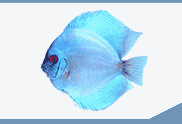

 |
||||||||||||
 |
||||||||||||
| Hybrid Tanks | ||||||
| Ralph Cote | ||||||
Somewhere between a fully planted, community tank with three inches of gravel and a bare bottom, discus only aquarium is the hybrid tank. It incorporates some of the advantages from the planted tank and some of the advantages from the bare bottom tank. This is by no means an exhaustive listing but is meant to give suggestions of possibilities for the majority of discus keepers who don't want either of the extremes. It's not meant as a how-to but it is a discussion of the pluses and minuses for each option. Several of the options can also be combined to tailor-make a tank that fully reflects your values and goals as a discus keeper. Some of the advantages to a hybrid tank may be (each case has different degrees of advantages):
Aerial Roots - Several common houseplants can be used at the surface of the tank with their roots in the water. The roots pull out nitrogen from the tank in the form of ammonia, nitrites, and nitrates. You still need a filter and water changes but any reductions of toxins in the water is a good thing. It has minor effects on O2 and CO2 levels. I like the look of roots in the tank but it may not be for everyone. It doesn't hamper tank cleaning and is an inexpensive, easy option. There is an article on Philodendrons that goes into more detail. Surface Plants - There are several aquarium surface plants that provide the same benefits of aerial roots and in addition give the discus a sense of protection. The plants may be more difficult to obtain though. Avoid the small leafed plants (duckweed, etc.) as they can be messy. Potted Plants - Using clay pots to hold the gravel substrate and plant roots, and putting them on the bare tank bottom, you get the impression of a planted tank. Solid wastes can be vacuumed off the bottom and the pots can be pulled for a complete cleaning periodically. The pots can be very visible, though you can use short pots or perhaps cover them. The gravel can be a mixture of fertilizing substrate too. Another easy care, inexpensive option that gives you the advantages of having plants while minimizing the problems of a gravel substrate. Unplanted Plants - I have three aquatic bulb plants that aren't in a substrate and they are all doing well. The best looking ones are the tall, full looking plants, such as Aponogeton boivinianus, because the bare bulb is less noticeable. I wrap a weight around the base to keep them down and they don't move around as much as you would think. They don't interfere with cleaning. Plastic Plants - The quality of fake plants have increased quite a bit and don't look nearly as fake. The cost has gone up accordingly. Of course you don't get the benefits of real plants, but for the brown thumb, it is so much easy to keep them looking good. Most are mounted to bases and are simple to place, move, or remove. more... |
 |
|||||
| About Us :: Message Board :: Chat | |||||
| Library :: Photo Gallery :: Links & Resources :: Breeders & Sponsors :: Merchandise | |||||
| Website designed by: EthanCote.com | © 2001-2004, SimplyDiscus.com. All Rights Reserved. | ||||